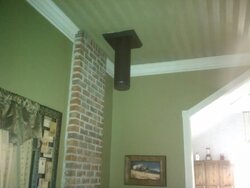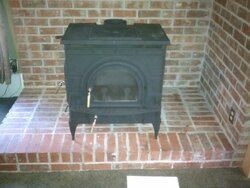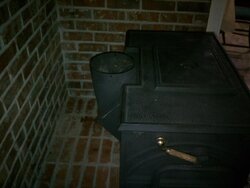First a little background. The House is civil war era but I have only owned it since March. I have had a chimney sweep look at the dbl wall insulated pipe and he said it was fine...no cleaning needed. Last evening we sat the 2461 on the hearth and centered it under the chimney. Measurements from the side wall to the center of the flue...33" back of hearth to center of flue...17 inches. According to VC's instructions, unprotected surfaces require min. of 35" and 17" when using a single wall with heat shields.
Question #1....I do not know what is under the brick. Are the hearth walls and floor considered protected or not. (wood framing floor and walls.
Question #2...Front of the unit is at the front edge of the hearth pad. Can the burner be placed in the corner? It sideloads from the left side. Can it just be moved straight back as it sits? It is a straight though the ceiling with no elbows as it is now, with no elbows. Any help would be appreciated...thanks!



Question #1....I do not know what is under the brick. Are the hearth walls and floor considered protected or not. (wood framing floor and walls.
Question #2...Front of the unit is at the front edge of the hearth pad. Can the burner be placed in the corner? It sideloads from the left side. Can it just be moved straight back as it sits? It is a straight though the ceiling with no elbows as it is now, with no elbows. Any help would be appreciated...thanks!






